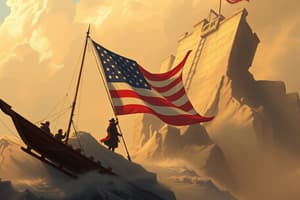Podcast
Questions and Answers
What is a primary reason for studying history?
What is a primary reason for studying history?
- To understand only one perspective
- To comprehend context and multiple perspectives (correct)
- To memorize dates and events
- To only learn about significant battles
Which colony was known for its diverse population and trade?
Which colony was known for its diverse population and trade?
- Dutch New York/New Amsterdam (correct)
- The Carolinas
- Virginia
- Massachusetts
What type of government was established by the Constitution?
What type of government was established by the Constitution?
- Monarchy
- Theocracy
- Oligarchy
- Democratic Republic (correct)
Which of the following statements regarding the Carolinas is accurate?
Which of the following statements regarding the Carolinas is accurate?
What was a takeaway from the Revolutionary period?
What was a takeaway from the Revolutionary period?
Flashcards
American Revolution
American Revolution
The period in American history when the thirteen colonies declared independence from Great Britain and fought for their freedom. It marked a significant turning point in the development of the United States.
Declaration of Independence
Declaration of Independence
A key document signed by the Continental Congress in 1776, declaring the thirteen American colonies independent from British rule. It outlined the principles of self-government, natural rights, and popular sovereignty.
Federal System
Federal System
A system of government established by the U.S. Constitution, characterized by a division of power between the federal government, state governments, and the people. It defines the three branches of government (legislative, executive, and judicial) and sets out the principles of checks and balances.
Westward Expansion
Westward Expansion
Signup and view all the flashcards
Gilded Age
Gilded Age
Signup and view all the flashcards
Study Notes
Office Hours
- Office hours are Thursday, N303, 1-2pm.
- IDs can be found at the link provided.
Unit 1: Introduction
- Studying history involves multiple perspectives and context.
- Indigenous Americans were focused on agriculture.
- The three sisters (corn, beans, and squash) were a vital part of the agricultural system.
- Indigenous American women played a significant leadership role within their communities.
- The Mississippi River was a crucial trade route.
- The Cahokia civilization was a large, diverse group with slavery as a part of their economy.
- Eastern Woodlands communities were smaller and more dispersed, primarily focused on hunting and agriculture where women played an important farming role.
- Communities of the Pacific Northwest had a surplus of food due to proximity to water, which led to a significant amount of leisure time.
Unit 2: Colonies and Colonization
- Settlers from England came for religious reasons and to establish a new community.
- Communities were often focused on population growth, and decisions within the community were often made collectively.
- Religious leaders were often political leaders.
- Religious tolerance varied significantly between colonies, specifically in religious states.
- Trade wasn't a primary focus for early settlements..
- Early settlements heavily relied on labor enslavement in some colonies, particularly Virginia.
Unit 3: Separation and Revolution
- Consumers in the colonies began buying more goods.
- Colonists participated in boycotts and protests.
- Resistance against taxation occurred at various levels from different groups in the society.
- There was a conflict between the elites and the general population.
- Revolution was driven largely by elites.
Unit 4: Constitution and Early Republic
- Slavery is mentioned in the constitution.
- There is a provision for counting enslaved people for purposes of representation.
- Fugitive slave laws existed.
- The supremacy clause gave federal power over states on specific issues.
- The fifth amendment protects against self-incrimination and double jeopardy.
- The constitution focused on preventing conflicts between the government and the people.
- Three branches of government exist in the constitution: legislative, executive, and judicial.
- Five freedoms (religion, speech, press, assembly, and petition) are guaranteed in the first amendment.
- The constitution created a central bank for the country.
- Taxes are part of financial and fiscal policy.
- The country developed policies to make tariffs more fair during this time period.
- Conflicts over taxation and economic regulation existed.
Unit 5: Race, Rights, and a Shifting Republic
- Republican motherhood emphasizes women's role in raising children.
- Conflicts between the north and south continue to rise during this period.
- Expansion of the country and new land acquisition created tension about the issues associated with slavery's expansion.
Unit 6: Abolitionism, Sectional Crisis, and War
- Religious and moral arguments for abolition existed.
- Garrison's The Liberator was a critical antislavery newspaper.
- The Wilmot Proviso (proposed banning slavery from new territories).
- The Dred Scott decision deemed enslaved people as property.
- The Compromise of 1850 was intended to address the disputes between the North and South on the issue of slavery in newly acquired territories.
Additional Information
- Women wanted rights and more autonomy.
- The roles of women changed over time in the revolution.
- Slavery was a significant and unresolved issue in the colonies.
- Various groups played an important role in the movement toward abolition.
Studying That Suits You
Use AI to generate personalized quizzes and flashcards to suit your learning preferences.




